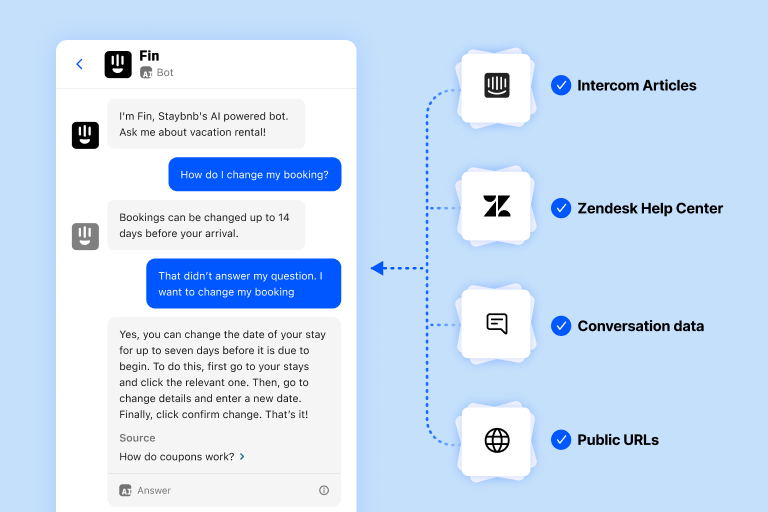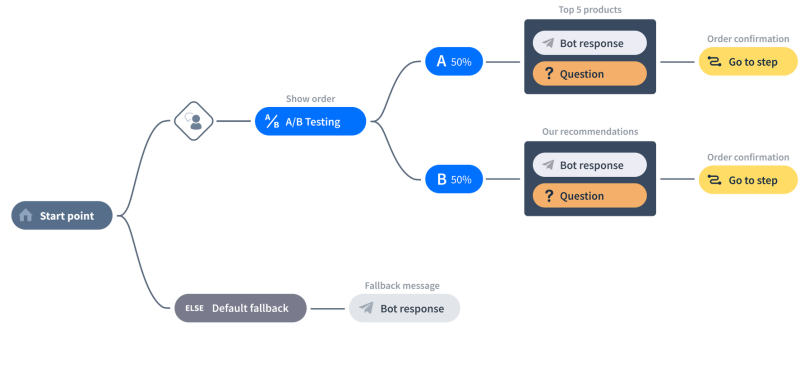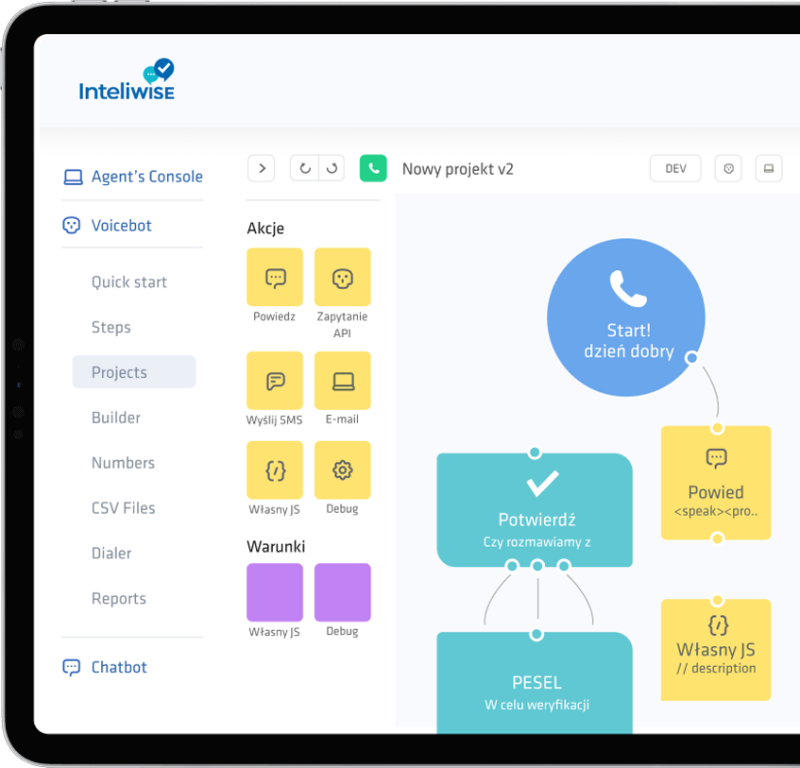Chatbots and voicebots have firmly settled in the landscape of e-commerce and online services. They offer help on bank and auction sites, answer questions about restaurant menus on Messenger, provide entertainment and even take care of our health. They are currently the most popular way to implement conversational artificial intelligence in e-commerce customer service. They help provide 24/7 accessibility and personalized shopping experiences. However, each of these technologies has its strengths and weaknesses.
Chatbot vs voicebot – table of contents:
- How do chatbot vs voicebot work in e-commerce customer service?
- Chatbot vs voicebot in e-commerce. What are the similarities?
- The differences: chatbot vs voicebot
- Create a consistent customer experience with chatbots and voicebots
- What questions to ask yourself when choosing chatbot vs voicebot?
- Chatbot vs voicebot. Which solution to implement in your company?
How do chatbot vs voicebot work in e-commerce customer service?
According to the latest forecasts, the chatbot market will reach $454.8 million in revenue by 2027. This compares to $40.9 million in 2018. More and more companies are offering off-the-shelf chatbots and voicebots that integrate with e-commerce platforms and enable to automate a significant portion of customer inquiries.
Chatbots in e-commerce
A chatbot is a computer program with which the user has a text-based conversation. It typically runs on a website or instant messaging service such as Messenger. Chatbots can be:
- Rule-based – the simplest to operate, but requiring the manual establishment of rules of operation and input of answers to questions from which the customer will be able to choose. So they can answer questions about opening hours, or the status of an order,
- AI-based – by recognizing the topic of conversation and the intent of the questioner (intent recognition), they conduct a conversation similar to a natural one using data on, for example, a customer profile or store regulations.
Both types of chatbots can answer customers’ questions about the status of an order, or help them find the right products on a store’s website. The main difference is that the AI-based chatbot learns from the help content without additional training or rule-setting. It understands the intent behind customers’ questions and uses the help content to generate personalized answers. Thus, questions do not need to contain keywords for the chatbot to understand them. This makes interactions with them feel more natural to customers.
Voicebots in e-commerce
Voicebot, on the other hand, talks to customers through speech. It works, for example, on smart speakers or mobile apps.
The simplest in-store voice assistant answers questions about products and store operations in voice form in a similar way to a rule-based chatbot. However, AI voicebots can combine functions of:
- salesperson – welcoming the customer to the store’s website and advising during the purchase,
- sales representative – inquiring about customer needs and expectations,
- support department – checking order status and answering FAQs
Voicebot integrated with e-commerce will redirect the call to an employee only for unusual tasks or those requiring a decision beyond standard operating procedures.
Chatbot vs voicebot in e-commerce. What are the similarities?
Both technologies, chatbots and voicebots use advanced artificial intelligence algorithms that analyze natural language to understand intentions and generate responses. They can also learn from human conversations.
Technically, however, the two technologies work similarly:
- They accept input from the user in the form of text or speech.
- They analyze them with NLP to understand intentions and “extract” information.
- Based on this, they formulate a response in natural language – text or voice.
- In some solutions, they combine machine learning and deep learning to continuously improve the quality of understanding and responses.
This allows chatbots and voicebots to, among other things:
- provide advice,
- answer frequently asked questions,
- recommend products,
- take orders or
- solve customer problems.
They are therefore an invaluable aid to customer service departments.
The difference between chatbot and voicebot lies primarily in the user interface. A chatbot communicates via text while a voicebot with voice. Therefore, voicebots additionally require speech recognition and synthesis technology.
The differences: chatbot vs voicebot
Chatbots primarily simplify website navigation and product finding. For example, they can help search for specific models, suggest alternatives or complementary products. AI chatbots are more suitable for those in need of accessing visuals, such as images or links.
In addition, the chatbot can guide the customer through the purchase process, handle payment or help track the status of an order. All this without having to contact customer service.
Voicebots, on the other hand, are great as mobile, voice-based advisors. For example, customers can call your store to ask for help with product selection. The voicebot can ask a few questions to better understand the customer’s needs and then suggest the best options.
Curiously, such a voice assistant can check in real time the availability of specific models in stock and inform the customer. It can also act proactively – call the customer with information about a change in the status of an order or ask for feedback. However, voicebots require speech recognition and synthesis, which can introduce more errors or delays in the conversation.
Create a consistent customer experience with chatbots and voicebots
To provide customers with a satisfying experience when using chatbots and voicebots, companies need to ensure their integration and consistency. One of the key challenges is how seamlessly a customer can switch between channels – for example, starting a conversation on a chatbot and continuing it after switching to a conversation with a consultant. That’s why a crucial part of integrating a chatbot with e-commerce is a BOK employee’s access to the customer’s data and conversation to maintain the context of the conversation and its continuity. According to Zendesk research, as many as 62% of customers expect their experience to transition seamlessly between the physical and digital spaces.
Equally fundamental is a natural, friendly tone of voice for voicebots – too stiff, robotic speech can, unfortunately, put off customers. A well-designed voicebot should sound like a real consultant and reflect the brand’s personality. Fortunately, CX is improving as technology advances, and according to the survey, as many as 65% of business leaders believe that voicebots in their companies are becoming more natural.
To ensure consistency, chatbots and voicebots must also integrate seamlessly with other channels, such as email and mobile apps. Only harmonious cooperation across the entire customer service system will bring success. But how do you choose whether a chatbot or voicebot is better for your store?
What questions to ask yourself when choosing chatbot vs voicebot?
Here are some key questions to help you decide chatbot or voicebot:
- Who are your customers and what are their preferences and behaviors? This question will help you understand your customers’ needs and expectations, as well as their preferred method of communication. For example, if your customers are young, tech-savvy and mobile-oriented, they may prefer chatbots to voicebots. If your customers are older, less adept at typing, or have accessibility issues, they may prefer voice bots over chatbots.
- What are your customers’ goals and pain points, and how can you solve them? This question will help you define the value proposition and use case of your conversational artificial intelligence solution. For example, if customers want to quickly order a pizza or book a flight, they may prefer voice bots to chatbots. If customers want to compare products, read reviews or get detailed information, they may prefer chatbots over voicebots.
- What channels and platforms do customers use to interact with your business? This question will help you choose the best delivery method and integration options for your conversational artificial intelligence solution. For example, if your customers use social media, messaging apps or websites to contact you, they may prefer chatbots over voicebots. If your customers use phone calls, smart speakers or voice assistants to contact you, they will tend to prefer voice bots over chatbots.
- What technical and financial resources do you have at your disposal to develop and maintain your conversational artificial intelligence solution? This question will help you assess the feasibility and scalability of your conversational artificial intelligence solution. For example, if you have limited resources or expertise, you may prefer chatbots over voicebots. Chatbots are generally easier and less expensive to develop and maintain than voicebots. Voicebots require more advanced technologies and skills, such as speech recognition and synthesis, which can increase the cost and complexity of the solution.
A reliable answer to these questions will allow you to consciously choose a chatbot or voicebot that will be best for your e-business.
Chatbot vs voicebot. Which solution to implement in your company?
Here’s an overview of the most popular chatbots and voicebots so you can make an informed and independent choice of the best solution for your e-commerce business.
- Tidio Lyro (https://www.tidio.com/lyro/) – statistics released by the solution’s creators show that Lyro solves 70% of the problems reported by customers within seconds. So it’s worth trying out the solution, especially since the first 50 conversations can be done for free, even in the free plan. Tidio also offers rule-based chatbots that are not AI-assisted – these, however, require manual rule-setting and the user to enter optional responses himself.
- Intercom Fin (https://www.intercom.com/fin) – based on GPT-4, the best conversational model from the makers of ChatGPT, is used to communicate with customers across almost all channels, such as email, live chat, phone and social media. It helps improve e-commerce customer service by automating frequent inquiries, personalizing messages and analyzing user behavior. Learning how to use this complex tool is relatively easy, thanks to Intercom’s extensive Academy and a brilliantly done help section, using a chatbot, of course. Intercom’s price depends on the plan and the number of users and starts at $39 per month per user. Unfortunately – it quickly increases with the number of features. Fin currently costs $0.99 per resolved case – a huge plus for Intercom’s developers that they only charge on successful calls.
- ChatBot Livechat (https://www.livechat.com/chatbot/) – is a solution that allows you to communicate with your customers via a chatbot with the option to switch to live chat, on your website or mobile app. It helps improve e-commerce customer service by providing quick and easy answers, sending proactive messages and automating frequent inquiries with chatbots. Learning how to use this tool is quite easy thanks to its intuitive interface and rich documentation. The price of Livechat integrated with ChatBot depends on the plan and the number of users and starts at $16 per month per user.
- Voicebot InteliWISE – makes appointments with customers, reminds them of appointments, reschedules appointments, calls phone numbers and completes data in CRM without the need for a consultant. It’s a solution that allows you to create voice assistants that can communicate with customers via phone or live chat. The price of Voicebot InteliWISE depends on the plan and the number of users and starts at PLN 99 per month per user.

Source: Intercom Fin (https://www.intercom.com/fin)

Source: ChatBot (https://www.chatbot.com/)

Source: ChatBot (https://inteliwise.com/)
A key consideration when choosing a chatbot or voicebot is, of course, cost. At first glance, a voice bot may seem more expensive to implement. After all, it requires additional technologies related to speech recognition and synthesis.
However, when comparing the overall budget, the differences are not that big. The two largest cost items for both technologies are the licensing fee for the use of the conversational AI engine, and the cost of the developers and customer support team to configure and continuously develop the bot.
AI engines are now becoming cheaper and more accessible. E.g. solutions in the AI-as-a-Service model allow you to use ready-made models without having to build your own from scratch. In general, the cost of building your chatbot starts at around £15k for an MVP version. Voicebots can be 20-30% more expensive. So it’s worth analyzing additional factors, such as ease of integration and impact on conversions. This will help you decide which technology will work better for your business.
It is also worth remembering that “off-the-shelf” solutions, i.e. ready-made chatbots and voicebots available in a subscription model, are not the only option. For many companies, a tailor-made chatbot with its character, which will exactly meet expectations, may be a better solution. On top of that, comparing the annual subscription price of off-the-shelf solutions with the cost of creating a chatbot whose use will not require a monthly subscription fee, it may turn out that a personalized chatbot will do better. Especially since the implementation of a tailored solution can significantly increase the number of customer inquiries that will not require human involvement to resolve.

If you like our content, join our busy bees community on Facebook, Twitter, LinkedIn, Instagram, YouTube, Pinterest, TikTok.
Author: Robert Whitney
JavaScript expert and instructor who coaches IT departments. His main goal is to up-level team productivity by teaching others how to effectively cooperate while coding.
AI in e-commerce:
- E-commerce automation. 5 areas of e-commerce worth automating using artificial intelligence
- Marketing texts for e-commerce with the help of artificial intelligence. 5 best tools
- Advertising graphic design with AI
- Customer feedback management with AI. Can Artificial intelligence take care of your online store's reputation?
- The AI revolution in e-commerce
- Personalization of e-commerce customer communication in the new era of AI
- Chatbot vs voicebot - which one to choose for e-commerce?
- AI keys to increase sales in e-commerce
- Optimizing e-commerce pricing strategy with artificial intelligence
- E-commerce pricing management. 4 best AI tools
- The future of e-commerce. What business opportunities are opening up for shopping in the metaverse?


















